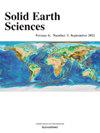Unraveling plate tectonics: From mantle plumes to subduction dynamics
IF 2
4区 地球科学
Q3 GEOSCIENCES, MULTIDISCIPLINARY
引用次数: 0
Abstract
The origin and evolution of plate tectonics are essential for understanding Earth's habitability, intricately linked to deep mantle convection, core-mantle interactions, and mantle plumes. Despite substantial advancements in the field, critical gaps remain in our understanding of how these processes interrelate and influence Earth's evolutionary trajectory. This review provides a comprehensive synthesis of the evolutionary dynamics of plate tectonics, focusing on the mechanisms of subduction initiation and its effects on core-mantle boundary structures and mantle plume formation. Throughout Earth's geological history, from the late Hadean to the present, plate tectonics has undergone significant evolution, with a transition from early mantle plume control to present plate negative buoyancy mechanisms in subduction initiation. We highlight how subducting slabs drive mantle flow, modifying the properties and dynamics of the core-mantle boundary and influencing mantle composition, leading to seismic anisotropy and the emergence of mantle plumes. Our findings underscore that tectonic evolution is fundamentally tied to thermal processes, shifting from spontaneous cooling to externally driven mechanisms. We advocate for future research to clarify the changes in heat and material transfer between the core and lower mantle induced by subduction, as well as their implications for physical and chemical properties of the core-mantle boundary. Understanding these dynamics is crucial, as they directly affect surface tectonic activity, volcanic eruptions, and broader environmental changes, thereby advancing our knowledge of the Earth system's intricate relationships.
解开板块构造:从地幔柱到俯冲动力学
板块构造的起源和演化对于理解地球的可居住性至关重要,它与深部地幔对流、地核-地幔相互作用和地幔柱有着错综复杂的联系。尽管该领域取得了重大进展,但我们对这些过程如何相互关联并影响地球进化轨迹的理解仍然存在重大差距。本文综述了板块构造演化动力学的综合研究,重点讨论了俯冲起始机制及其对核幔边界结构和地幔柱形成的影响。纵观地球地质历史,从晚冥古宙到现在,板块构造经历了重大的演化,从早期地幔柱控制到现在俯冲起始的板块负浮力机制转变。我们强调了俯冲板块如何驱动地幔流动,改变核幔边界的性质和动力学,影响地幔成分,导致地震各向异性和地幔柱的出现。我们的研究结果强调,构造演化从根本上与热过程有关,从自发冷却转向外部驱动机制。我们主张进一步研究俯冲引起的地核和下地幔之间的热量和物质传递变化及其对地核-地幔边界物理和化学性质的影响。了解这些动力学是至关重要的,因为它们直接影响到地表构造活动、火山爆发和更广泛的环境变化,从而提高了我们对地球系统复杂关系的认识。
本文章由计算机程序翻译,如有差异,请以英文原文为准。
求助全文
约1分钟内获得全文
求助全文
来源期刊

Solid Earth Sciences
GEOSCIENCES, MULTIDISCIPLINARY-
CiteScore
3.60
自引率
5.00%
发文量
20
审稿时长
103 days
 求助内容:
求助内容: 应助结果提醒方式:
应助结果提醒方式:


